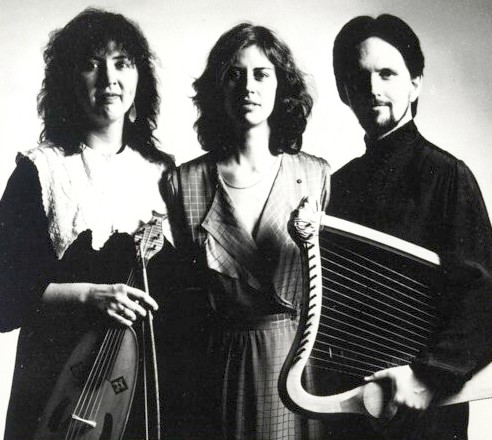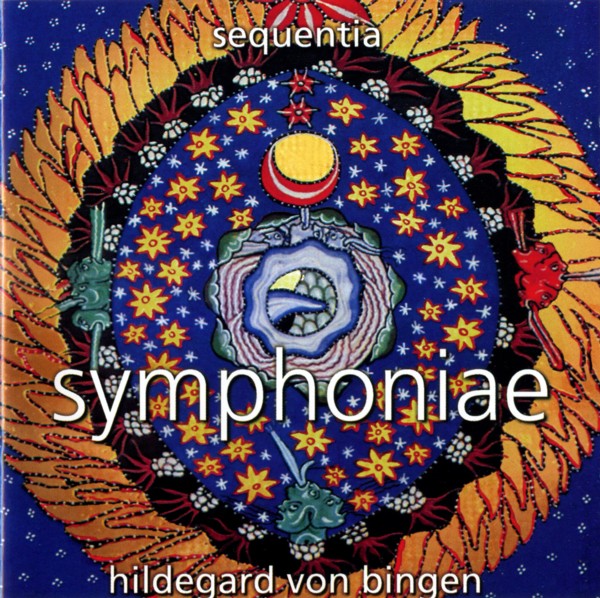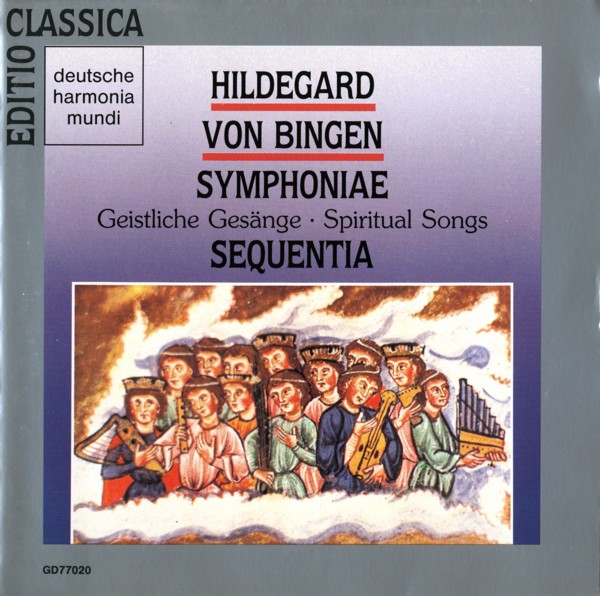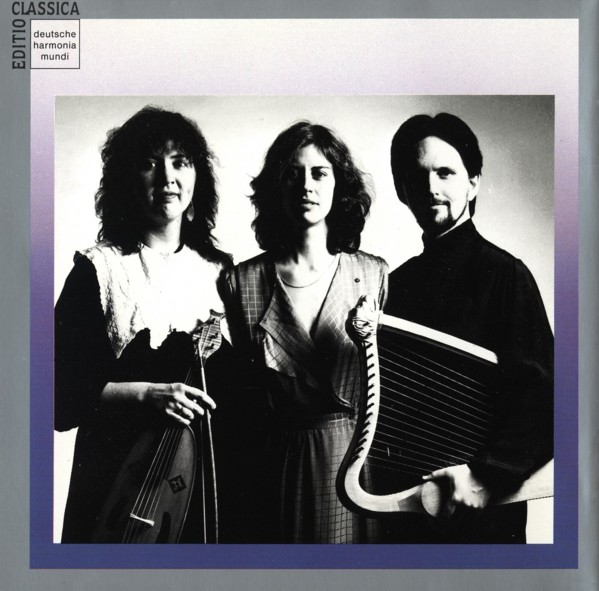HILDEGARD von BINGEN. Gestliche Gesänge / Sequentia
Symphoniae
Symphonia harmoniae caelestium revelationum

medieval.org
grabación: 1982-1983
LPs:
1983 · Harmonia Mundi (BASF) 74321 20 198-2 [LP]
1985 · Deutsche Harmonia Mundi (EMI) 1C 067 199 976 1 [LP]
CDs:
1987 · Deutsche Harmonia Mundi (EMI) CDC 7 49251 2 [CD]
1989 · Deutsche Harmonia Mundi (BMG) "Editio Classica" 77020-2-RG [CD]
2004 · Deutsche Harmonia Mundi (BMG) "Splendeurs" 82876 60152 2 [CD]
[Seite 1]
1. O quam mirabilis [2:41]
antiphona · JF
2. O pulchrae facies [3:55]
antiphona [De Virginibus] · Vokalensemble, 2 Fideln, Harfe
3. O virga ac diadema [4:50]
sequentia [De Sancta Maria] · BTh, CS, Vokalsensemble
4. Instrumentalstück I [1:53]
2 Fideln, Flöte, Harfe
5. O clarissima mater [8:07]
responsorium [De Sancta Maria] · SS, JF, ThL, CT, Flöte
6. Instrumentalstück II [5:00]
2 Fideln, Flöte, Harfe
7. Spiritui sancto honor sit [4:56]
responsorium. [De Undecimum Milibus Virginibus] · LM, Vokalensemble, Fidel,
Psalterium, Harfe
8. O virtus sapientiae [2:53]
antiphona · Vokalensemble, Organistrum
[Seite 2]
9. O lucidissima Apostolorum turba [6:41]
responsorium [De Apostolis] · GL, Vokalensemble, 2 Fideln, Harfe,
Flöte
10. Instrumentalstück III [2:58]
Flöte, Harfe
11. O successores fortissimi leonis [2:10]
antiphona [De Confessoribus] · Vokalensemble, Fidel
12. O vos felices radices [5:07]
responsorium [De Patriarchis et Prophetis] · BTh, Vokalensemble, Symphonia
13. Instrumentalstück IV [5:19]
2 Fideln, Flöte, Harfe
14. Vos flores rosarum [5:46]
responsorium [De Martyribus] · Vokalensemble

SEQUENTIA
Ensemble für Musik des Mittelalters
BTh Barbara Thornton, Gesang, Leitung des Vokalensembles
Margriet Tindemans, Fidel, Psalterium, Leitung des
Instrumentalensembles
Benjamin Bagby, Harfe, Organistrum, Symphonia
mit
Gesang:
JF Jill Feldman
GL Guillemette Laurens
ThL Theresa Lister
LM Lauri Monahan
Margaret Reines
SS Sally Sanford
CS Candace Smith
CT Caroline Trevor
Fidel: Sally Cunningham (#4, 6, 10, 13 - #7)
Flöte: David Hart (#4, 6, 10, 13), Liane Ehlich
(#9)

Bearbeitung der Instrumentalmusik von Margriet Tindemans und Benjamin Bagby
Aufgenommen:
16. —19.VI. 1982, Klosterkirche Knechtsteden
17.— 20.VI. 1983, Mandelsloh, St. Osdag
Thomas Gallia (#4-6, 10, 13) · Barbara Valentin
Produzent: Klaus L Neumann
Schnitt: Paul Dery · Barbara Valentin
Technik: Sonart, Milano (#4-6, 10, 13) · WDR: Hermann Kaldenhoff
Quellen:
Wiesbaden, Hessisches Landesbibliothek, Hs. 2 („Rupertsberger
Riesenkodex") fol. 466-473
Dendermonde (Belgien/Belgium), Klosterbibliothek Cod. 9
(„Villarenser Kodex"), fol. 156-167

SYMPHONIAE
Hildegard (born in 1098) began to compose liturgical poetry and music
in the 1140s, at the time when she first felt the courage to write down
her visions. Already in 1148 a Parisian magister, Odo,
commended the originality of her songs; in the 1150s she gathered them
into a lyrical cycle, that she called her 'Symphony of the harmony of
heavenly revelations' (Symphonia harmoniae caelestium revelationum).
This, in its first version, contained some sixty antiphons,
responsories, sequences and hymns, suited to many feasts of the
liturgical year. In the twelfth century only Peter Abelard, in the
1130s, attempted a cycle of liturgical composition on so large a scale.
Close study of the two manuscripts in which her cycle is preserved
enables us to distinguish also a later, enlarged version of the Symphonia,
where Hildegard had added some outstanding songs, including two of
those performed here: the two antiphons with more philosophical themes
— on divine foreknowledge (I) and divine Wisdom (VIII) —
probably belong to the time of Hildegard's last major work, her
cosmology Liber divinorum operum (1163-73). Lyrical invention,
that is, retained a distinctive, though gradually less prominent, place
in Hildegard's astonishingly varied and prolific writing. Symphonia
is a key concept in Hildegard's thought, and one that she discusses in
early as well as late works. It designates not only a harmony of
diverse notes produced by human voices and instruments, but also the
celestial harmony, and the harmony within a human being. The human
soul, according to Hildegard, is 'symphonic' (symphonialis), and
it is this characteristic that expresses itself both in the inner
accord of soul and body and in human music-making. Music is at the same
time earthly and heavenly — produced by earthly means, but able
to evoke for mankind, at least briefly and partially, the heavenly
consonance ('Stimmung') that they possessed fully in Paradise before
the Fall. In the words of Hildegard's younger contemporary, the
poet-theologian Alan of Lille, a symphonia implies an
exultation of the mind, to which the vocal celebration and the
instrumental execution correspond. Thus, with the consonance of mind
and voice and instruments, the symphonia becomes a 'good work'
in an existential as well as an artistic sense.
Hildegard's poetic language is among the most unusual in medieval
European lyric. She shows herself aware of the imagery of mystical love
in the Song of Songs, as well as of certain traditional figural
relationships elaborated by the Church Fathers. Thus for instance both
Ecclesia and a virgin martyr can be portrayed as the bride of the
divine Lamb; Mary is seen as the healer of Eve's guilt, or as the
flowering branch of the tree of Jesse, or as the dawn in which Christ
the Sun rises. But in developing such images and expressions Hildegard
delights in poetic freedom, and in taking diverse kinds of language to
new limits. I would signal especially her daring mixed metaphors, her
insistent use of anaphorai, superlatives and exclamations, her
intricate constructions in which several participles or genitives
depend on one another. In one of her most compressed songs (XII), the
patriarchs and prophets are the roots of a fruitful plantation whose
summit, which they foreshadow, is Christ, but Christ is at the same
time a whetstone, that is heralded by a fiery voice (John the Baptist),
and that demolishes an abyss (in the harrowing of hell). Hildegard's is
a lyrical language that sparkles with intellectual innovation while
remaining rhapsodic in its impulses. In the English translation I have
tried to reflect as far as possible the superbly obstinate
individuality of her diction. Her poetic effects are often strange or
violent, and never (as in the hymnody of most of her contemporaries)
smooth.
Peter Dronke

As abbess of Rupertsberg, Hildegard's authority and creative output
increased significantly. Between 1151-1158 Hildegard was writing and
collecting her musical compositions (as mentioned in her second vision
cycle, Liber Vitae Meritorum). They were intended for
liturgical use at the convent, and called symphoniae harmoniae
celestium revelationum, a title meant to indicate their divine
inspiration as well as the idea that music is the highest form of
praise in Creation, carrying as it does echoes of the sounds of the
heavenly spheres. We have two extant manuscripts of symphoniae,
yielding text and notated music for seventy-seven songs (as well as the
mystery play, Ordo Virtutum). (These are the Villarenser Codex
in Dendermonde, Belgium, and the Riesenkodex, Wiesbaden.) The songs are
generally praise songs to personages from the Christian pantheon of
saints, apostles, martyrs, virtues, deities, etc. Not surprisingly,
feminine figures are predominately worshipped — 15 of the songs
are addressed to the Virgin Mary, and 13 to Saint Ursula.
THE PIECES
1th SIDE
The first side of the recording reflects Hildegard's profoundly
feminine religious soul by presenting the texts and music she created
to praise those female divinities of her allegorical world — the
Virgin Maria, the virgins who inhabit heavenly realms at the end of
time, the St. Ursula, and the virtue of Wisdom, traditionally considered a type of feminine Deity.
O quam mirabilis (Antiphona)
Here is Hildegard's immensely loving depiction of life's central
miracle: creation. God breathed his breath into his creature and gazed
eternally into its face with ineffable love and knowledge.
De virginibus (Antiphona)
Hildegard sees virgins as pure beings belonging to God. Their faces,
turned eternally towards Him, reflect his luminosity.
De sancta Maria (Sequentia)
This sequence show Hildegard's unconventional use of forms, for it
scarcely resembles the classical sequence of the period. There is no
poetic meter, and the logic of the verses depends entirely upon the
enlargement of her symbolic images. It demonstrates the great
importance she attributed to the miracle of virgin birth — as
Maria had been chosen as the vessel for the birth of the Deity, she
redeemed her sex from the sin of Eva, and served as the universal
symbol of spiritual receptiveness.
Instrumental piece
Instrumental music is another means, in Hildegard's view, of praising
the Creator, "So should we, acknowledging God in the faith, praise Him
eternally in song, and in joyful sound without end. 'Praise him with
the sound of the harp', of profound submission, 'and in the sound of
the zither', that honey-flowing song. 'Praise him with string-playing',
the salvation of humankind, and 'with the sound of the flute', of
divine protection".
Scivias III, 13
O clarissima mater
This is a piece which, in text and music, evokes an image of Maria as
all that is mild, soothing and exquisite. Unlike Christ's war-like
triumph over Death, hers has been a soft one of healing. The flute
accompaniment emphasizes the smoothness and brilliance of this vision
of the Virgin.
De undecim milibus uirginibus (Responsorium)
This composition praises the passion of St. Ursula and the legendary
11,000 virgins who "gathered around her like doves", and chose to
martyr themselves as she did.
O virtus sapientiae (Antiphona)
A short antiphon for the virtue of Sapientia or Wisdom, who is
extensively praised in the Book of Proverbs. It creates a sense of the
wonderful circular motion of the singing of seraphim, mixing images of
celestial omnipresence and feminine fecundity.
2nd SIDE
The second part of the recording is dedicated to laudatory pieces which
Hildegard received in the last revelation of the Scivias cycle.
In the penultimate vision, she has witnessed the end of Time and of the
World, and the falling away of all that was mortal. The triumphant
final vision consists of nothing more than the joyful sounds of eternal
praise. The heavenly voice says to her, "As if with one soul and one
heart these songs, (heard in the vision), praise the glory of those who
are in Heaven. Their melodies carry into the heavens that which the
word makes manifest. Thus, O mankind, you must heed this song sung in
most perfect accord of the mystical words of the prophets (De
patriarchis et prophetis), the song of (Christ's) widely proclaimed
and miraculous teaching, (De apostolis), the song of the
spilling of blood of those who faithfully sacrificed themselves, (De
martyribus), and the song of priestly mysteries (De confessoribus)."
Scivias III, 13.
Barbara Thornton






